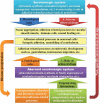The roles of serotonin in cell adhesion and migration, and cytoskeletal remodeling
- PMID: 34494935
- PMCID: PMC8437456
- DOI: 10.1080/19336918.2021.1963574
The roles of serotonin in cell adhesion and migration, and cytoskeletal remodeling
Abstract
Serotonin is well known as a neurotransmitter. Its roles in neuronal processes such as learning, memory or cognition are well established, and also in disorders such as depression, schizophrenia, bipolar disorder, and dementia. However, its effects on adhesion and cytoskeletal remodelling which are strongly affected by 5-HT receptors, are not as well studied with some exceptions for e.g. platelet aggregation. Neuronal function is strongly dependent on cell-cell contacts and adhesion-related processes. Therefore the role played by serotonin in psychiatric illness, as well as in the positive and negative effects of neuropsychiatric drugs through cell-related adhesion can be of great significance. In this review, we explore the role of serotonin in some of these aspects based on recent findings.
Keywords: Serotonin; antidepressants; antipsychotics; cell adhesion and migration; covid-19; cytoskeletal remodeling; development; homeostasis; immune cells; neuronal cells; platelet aggregation.
Conflict of interest statement
The authors declare no competing interests.
Figures


References
-
- Mohammad-Zadeh LF, Moses L, Gwaltney-Brant SM. Serotonin: a review. J Vet Pharmacol Ther. 2008;31:187–199. - PubMed
-
- Mordhorst A, Dhandapani P, Matthes S, et al. Phenylalanine hydroxylase contributes to serotonin synthesis in mice. FASEB J. 2021;35(6):(e21648). - PubMed
-
- Mosienko V, Beis D, Pasqualetti M, et al. Life without brain serotonin: reevaluation of serotonin function with mice deficient in brain serotonin synthesis. Behav Brain Res. 2015;277:78–88. - PubMed
Publication types
MeSH terms
Substances
LinkOut - more resources
Full Text Sources
